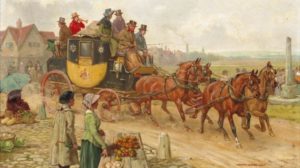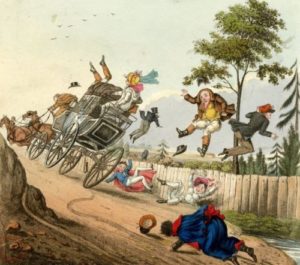
However, in many cases people used the mail coach or the stage coach. These coaches traveled on schedule much like today’s trains or airplanes.
One of the least expensive ways to travel was the Royal Mail. This ran over specific routes usually only once a day in either direction. They did not travel on Sundays or religious holidays, such as Easter or Christmas. The main coach’s purpose was to deliver the mail. Passengers were secondary, and the coachmen were very strict about keeping their schedule—even if it meant leaving a tardy passenger behind.

Private companies owned various stage coaches. These ran on their own schedules but kept to them as tightly as the mail coaches. They were dependable and often more crowded. They, too, were not supposed to run on Sundays or religious holidays, but some did in the interest of profit. The time they took to change horses was more relaxed and stops were worked into their schedules to give the passengers up to twenty minutes to get out to stretch, eat, and take care of personal needs.
Whether there was more than one stage or mail going out a day depended on the route. Generally, they ran once a day in each direction—or possibly even less depending the route. Well-traveled roads leading to cities and larger towns had more frequent trips. Several coaches used the same main roads for part of the journey, then split off to reach various end destinations. The destination determined whether the next coach out would be in two hours or the next day.
Coaches stopped during severe weather such as blizzards, and when snow blocked the roads, however, they generally ran regardless of the cold or rain. In a couple of cases, outside passengers froze to death.
Getting a seat on a coach could be difficult. Most sold out days in advance, so it was not easy to simply “catch” a ride. One bought tickets at the origin point for the mail or stage. Coachmen could sometimes be bribed to stuff in a passenger or give them an outside seat on the top of the coach, but it was not always possible. Horses can only pull so much weight, after all.
Coach Travel in Regency England, stage and mail coaches posted first on http://donnahatchnovels.tumblr.com/
No comments:
Post a Comment